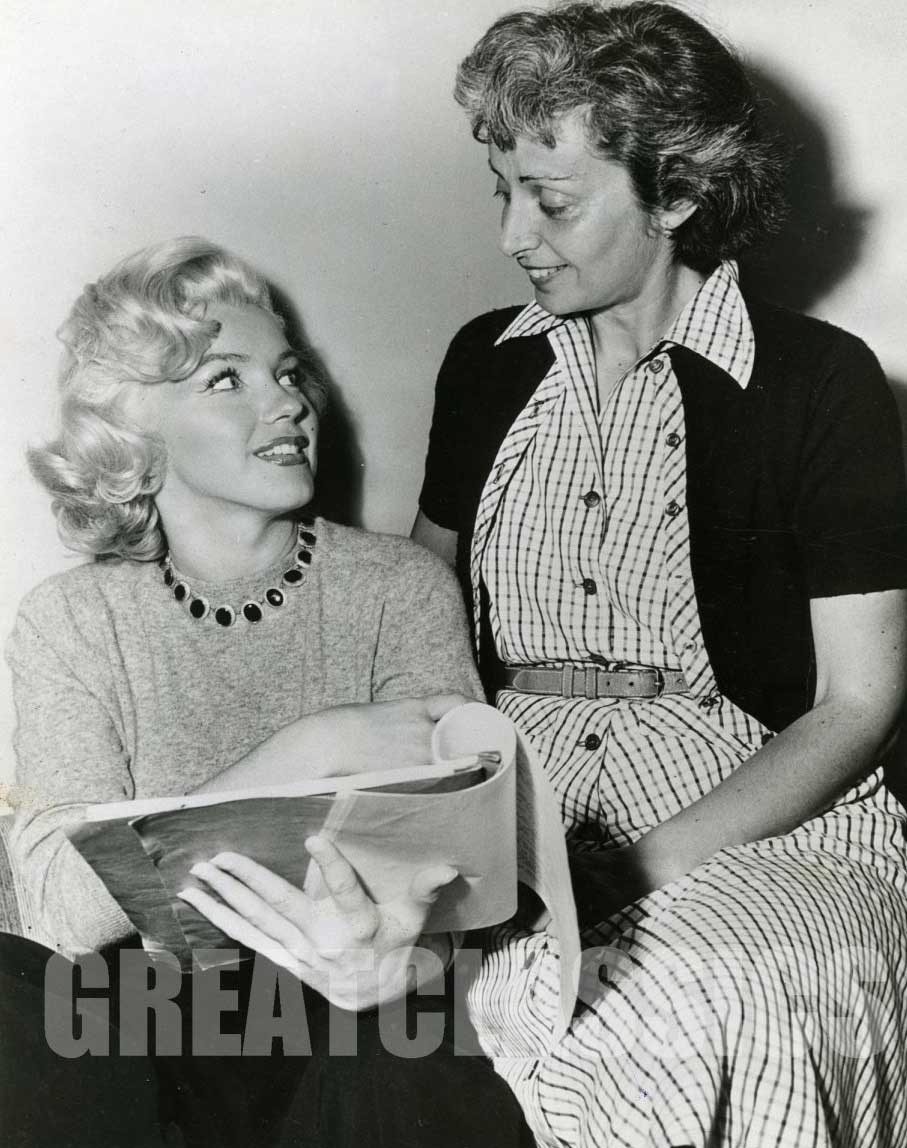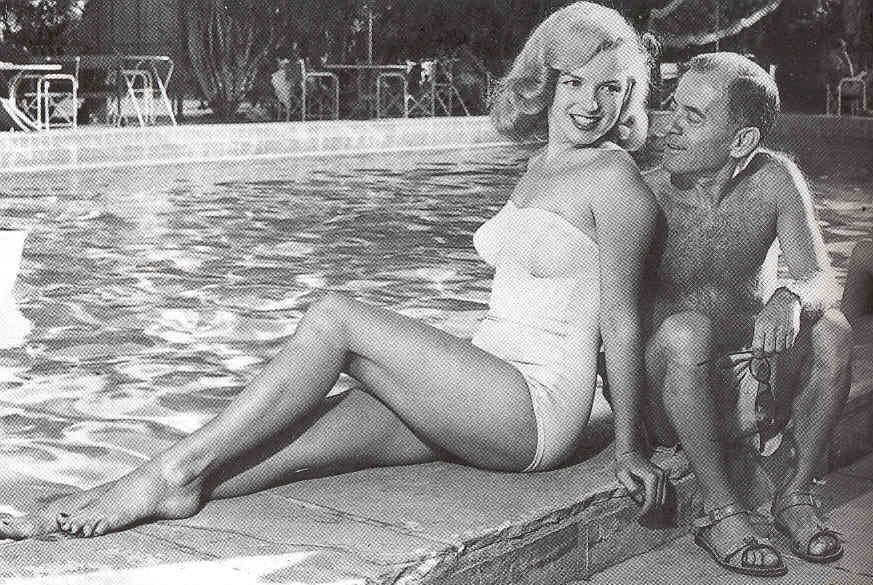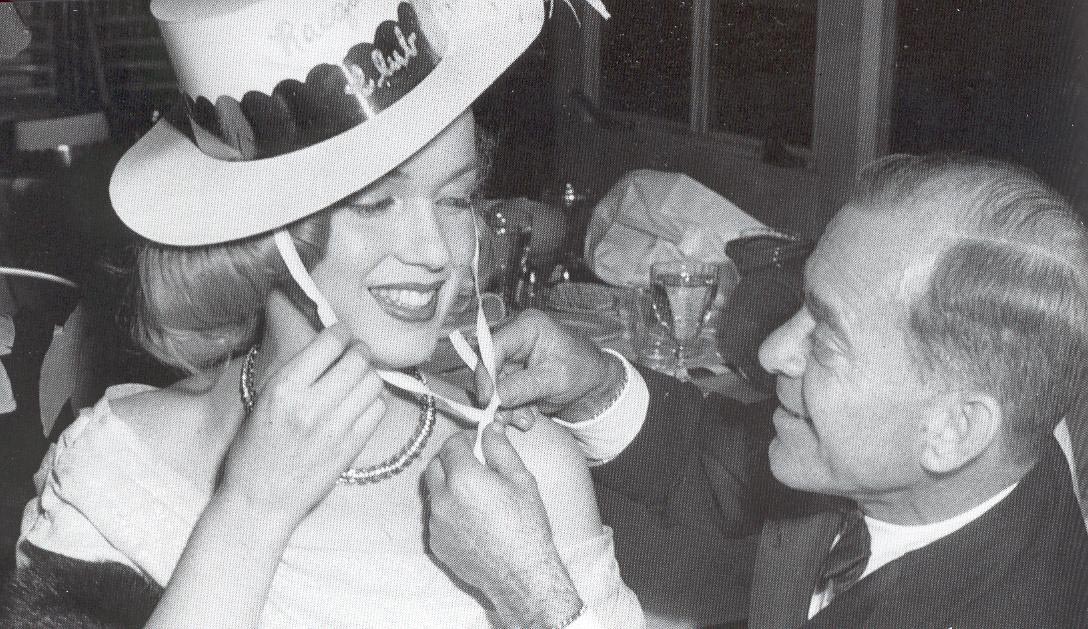Episode 1 continued: Marilyn’s early acting career
For this post, we wrap up the first episode of The Secret Life of Marilyn Monroe!
Special thanks to April for helping me a bit with the Gladys timeline
Special thanks to April for helping me a bit with the Gladys timeline
Links are here!
Part 1
Part 2
Part 3
Part 4
This area in the movie is a bit confusing, chronologically,
to any Marilyn historian. So rather than try to organize it, I’m just going to
explain the events depicted in the film and contrast them with what happened in
real life, no matter what order they’re in. To make it a little less hard to
track! And I even thought of a new way of breaking things down that I’ll start
doing. I’m going to begin listing film bits as “the movie” and real life as
“real life,” so it’s easier to separate and a little more comprehensive. Let me know if you like the new format of if it's too confusing.
(1) THE MOVIE: Kelli as Marilyn is very tipsy by this point
and after an award exchange with her psychiatrist, Dr. DeShields, Marilyn
expresses her concern that she is afraid of “becoming her mother.”
> (1) REAL LIFE: Marilyn lived her entire life in
constant fear that she would end up like her mother. She was afraid she would
inherit her mother’s mental illness and be locked up in an institution. Much
speculation about Marilyn’s mental state has been presented by Marilyn fans and
scholars. Some think she in fact had bipolar disorder, and some just think she
suffered severe depressive episodes. While it’s important to consider certain
aspects of her health, she cannot be diagnosed. You cannot diagnose a deceased
person. Marilyn was not diagnosed as bipolar, split personality, or any type of
mental imbalance while she was alive. What needs to be kept in mind is that
she, for the most part, had a horrible childhood. She was constantly abandoned,
shuffled back and forth between numerous foster homes and families, suffered an
incident of sexual abuse, and lived her life in constant question of why she
wasn’t wanted or loved. That’s more than enough to spark lifelong depression
upon anyone.
 |
| From "The Secret Life of Marilyn Monroe" |
(2) THE MOVIE: Gladys has another episode of being frightened
that people are following her, and she starts closing the curtains and running
about the house with worry. Grace attempts to restrain her on the sofa. Marilyn
hurriedly shows Gladys a gift she got her to calm her down. Inside is a white
nurse’s uniform and hat. Gladys snatches
it out of her hand and leaves the room to change into it, and Grace and Marilyn
are relieved that Gladys is now preoccupied with the gift.
> (2) REAL LIFE: This incident appears in the book The Secret Life of Marilyn Monroe, but
lacks any substantiation. With the confusing chronology of the movie, it’s
difficult to place the date the supposed event occurred, but if it is keeping
time with being after Marilyn posed for Tom Kelley in 1949, then Gladys would
be married to John Stewart Eley and living elsewhere in Los Angeles. Throughout
June and July of that year, Marilyn was off in other states promoting her film Love Happy. In August through October,
she was on location in Durango, Colorado filming A Ticket To Tomahawk.
(3) THE MOVIE: Kelli as Marilyn arrives at the home of
Natasha Lytess, played by Embeth Davidtz, who was suggested to her by Joe
Schenck. Lytess looks Marilyn over, evaluating her and asking her questions.
Marilyn stats that she is afraid of loneliness and that she just wants to be
loved.
> (3) REAL LIFE: This is all, for the most part,
true. Only Marilyn met Lytess through Columbia. In 1948, Marilyn’s 20th
Century Fox screen test was sent to Columbia pictures for consideration for
signing. One lady in the small group of people in the room viewing that test
was Columbia’s drama coach at the time, Natasha Lytess. Lytess, herself, was
unimpressed with Marilyn, but nevertheless agreed to work with her. Many people
thought that by working with her, Lytess was wasting her time trying to teach
this young starlet, but Marilyn paid for and attended her classes for several
weeks, and improvements were quickly showing. She was signed to Colmbia
Pictures in March of 1948 at $125 a week. She would work there for just six
months, completing just one picture, before they dropped her.
 |
| From "The Secret Life of Marilyn Monroe" |
 |
| Marilyn with Natasha Lytess, 1952. |
(4) THE MOVIE: Marilyn is at another party with Joseph
Schenck. This is an important one because this is the party where Schenck
introduces Marilyn to who would soon become one of the most important figures
in her life and career: Johnny Hyde.
> (4) REAL LIFE: Johnny Hyde was one of the biggest
names in Hollywood at the time. He was the vice president of the William Morris
Agency and he represented notable names
such as Rita Hayworth and Bob Hope. Marilyn and Johnny first met in 1949,
Marilyn in her early 20’s and Johnny in his 50’s. The two were introduced at a
party at the Racquet Club in Palm Springs. Marilyn was there on a modeling
assignment. Johnny convinced Lester Cowan to view her rushes from Love Happy.
Shortly after, she was signed to the William Morris Agency. For the rest of his
life, Johnny would beg Marilyn to marry him, so that she could inherit all of
his money after he died; he had a fatal heart condition. Marilyn loved and
respected him, and stayed loyal to him, but she refused to marry him. She would
not marry someone she was not in love with just to receive money as an
incentive.
 |
| Marilyn with Johnny Hyde. |
(5) THE MOVIE: Susan Sarandon as
Gladys is getting ready to leave Marilyn’s home, shortly after Marilyn informed
her that she has landed a role in the upcoming star-studded Fox production All About Eve. Gladys explains that she
is going to stay with Aunt Dora in Oregon for the time being.
> (5) REAL LIFE: If Marilyn had just received word
she was to have a role in Eve, this
would place this point in Secret Life the
film taking place in March of 1950, when Marilyn first signed her contract to
appear in Eve. She would work on Eve from the end of March to May 1950. Gladys’s
whereabouts in 1950 aren’t really known, she was for the most part off by
herself. According to Berniece Miracle, she stayed in Oregon late in 1946.
(6) THE MOVIE: Kelli as Marilyn is seen at Natasha Lytess’s
home rehearsing a part in All About Eve.
She is visibly nervous and breathing heavy. She suddenly interrupts her reading
in a panic. She is afraid that people are listening in on her. “They’re talking
about me,” she yells. “You don’t hear that? I can’t do this while they’re out
there!” Natasha pulls back the curtain and surveys the outside, trying to
explain to Marilyn that there is no one out there. Marilyn then collapses into
a ball of nerves in Natasha’s lap as Natasha tries to soothe her and comfort
her.
> (6 )REAL LIFE: Marilyn often stayed at Natasha’s
home to rehearse lines and attend private coaching. As we determined earlier,
Marilyn was terrified of inheriting her mother’s mental illness. Gladys was
schizophrenic. Marilyn was not. By no
accounts from anyone who knew her personally did she ever “hear voices” or
think people were “listening in on her.” Marilyn never displayed this type of
behavior, which is constantly being mentioned in Taraborrelli’s The Secret Life of Marilyn Monroe and is
simply not accurate. So it’s safe to say that all of the dramatic and psychotic
episodes that are portrayed in this film never happened, so I will be avoiding
further detailed discussion about them, assuming you get the point.
 |
| From "The Secret Life of Marilyn Monroe" |
(7) THE MOVIE: Kelli as Marilyn is
in the midst of filming a scene for All
About Eve. Johnny Hyde appears on set to hand her an urgent note. The note
reads that Gladys, although gone for a few weeks, never made it to Oregon. This
immediately stresses Marilyn out, who becomes worried for her mother’s
whereabouts. Johnny Hyde is surprised to find out that Gladys is alive, as he
and the entire Hollywood world were under the impression that her mother had
died a long time ago, and that Marilyn had grown up an orphan. Hyde promises to
find Gladys, and hands Marilyn some pills to calm her down, which she
reluctantly accepts.
> (7) REAL LIFE: As a rising starlet, Marilyn had
always informed the press that she had been orphaned at a young age. This was
done to protect Gladys’s privacy, only the truth came out eventually.
Fortunately, she received much sympathy for this, rather than criticism for
lying. In addition, it’s no secret that Marilyn was addicted to sleeping
medication for much of her life. Had she been provided proper help, she might
still be alive today. Johnny passed away from his heart condition in December
of 1950. He was like a father figure to Marilyn, and she was devastated when he
died. Natasha recalls an event in which she returned home one day to find
Marilyn unconscious in her bed, after an apparent suicide attempt from sleeping
pills. She had to be rushed to a nearby hospital to have her stomach pumped.
 |
| From "The Secret Life of Marilyn Monroe" |
 |
| Marilyn with Johnny Hyde, 1949. |
(8) THE MOVIE: Johnny Hyde walks up to Marilyn during a
promotional photo shoot, informing her that her mother’s new husband, John
Stewart Eley, has a wife in Boise, Idaho, and that Gladys was not aware of it.
> (8) REAL LIFE: John Stewart Eley and Gladys Baker
wed in April of 1949. Eley was an electritian from Boise, Idaho. There is
nothing to substantiate the story about Eley being married to a woman in Idaho
at the time he was married to Gladys. According to his obituary from 1953, he
only left behind his sister and Gladys. The wife story may have come directly
from Gladys, who would likely have created it and worried about it as a result
of her mental illness.
 |
| From "The Secret Life of Marilyn Monroe" |
(9) THE MOVIE: Kelli as Marilyn is
seen rehearsing her big musical number, Diamonds
Are A Girl’s Best Friend, for the movie Gentlemen
Prefer Blondes. She soon receives a note from Zanuck stating that they have
granted her request for a dressing room, but that they declined to increase her
salary. “The picture’s called ‘Gentlemen Prefer Blondes,’ and I’m the blonde!
If this picture’s a hit, things are gonna change around here.”
> (9) REAL LIFE: For the production of Blondes,
Jane Russell was loaned out to Fox for $200,000. This was a much smaller amount
than Marilyn was getting paid for. Marilyn’s contract at 20th had
her earning just $500 a week. She had equal star billing to Jane, so it’s
understandable she would be upset and feeling like she deserved more money for
an equally important performance. In her last interview from July 1962, she said:
“She, by the way, was quite wonderful to me. The only thing was I couldn’t get
a dressing room. I said, finally –I really got to this kind of level – I said
‘Look, after all, I am the blonde and it is Gentlemen
Prefer Blondes!’ Because still they always kept saying, ‘Remember, you’re
not a star.’ I said ‘Well, whatever I am, I am
the blonde!’”
 |
| From "The Secret Life of Marilyn Monroe" |
(10) THE MOVIE: Marilyn is with her
team getting ready to attend the Photoplay Awards. She is surprised when Gladys
suddenly barges in the room and begins frantically closing the curtains.
> (10) REAL LIFE: Gladys stayed at Rockhaven
sanitarium from 1953 to 1967. Before this, she was staying with the Bolenders,
the first foster family that took care of Norma Jeane. In October of 1952,
Grace McKee wrote Marilyn suggesting that Gladys be transferred to Rockhaven,
which ultimately wouldn’t happen until February of the following year. Gladys
was admitted there on the same day as the night of the Photoplay Awards (February
9, 1953), although some evidence suggests that may have been the day before, on
the 8th. Whatever the case, Marilyn did not see her. The whole fiasco with
Gladys at Marilyn’s house depicted in the movie never happened.
 |
| From "The Secret Life of Marilyn Monroe" |
(11) THE MOVIE: Kelli as Marilyn
arrives at the Photoplay Awards looking exquisite in a replica of one of the
most famous dresses in Marilyn history: the gold one used in Gentlemen
Prefer Blondes and designed by William Travilla. I didn’t notice this
little detail until watching the movie this time around, but you can see
Marilyn walk right past Giacomo Gianniotti, who plays Jim Dougherty, Marilyn’s
first husband. He is a cop holding back the screaming fans. Next, while being
interviewed, Kelli as Marilyn says “With the right pair of shoes, a girl can
conquer the world!”
> (11) REAL LIFE: Marilyn looked beautiful this
night as she received the award for “Fastest Rising Star of 1952.” The part
about Jimmy being a cop is true, but he was not there that night. The last time
Jim Dougherty saw Marilyn, then Norma Jeane, was at the end of their marriage. Dougherty
had joined the LAPD not long afterwards, and was in fact part of the security
team controlling the crowds at the premiere of The Asphalt Jungle in 1950. That would have been the only
opportunity for him to see her, only she did not attend. Lastly, the quote
about giving a girl the right shoes is fake, a misquote. Didn’t come from
Marilyn. It actually came from Bette Midler, and the original quote goes
something like “Give a girl the correct footwear and she can conquer the
world.” Didn’t know? Now you do!
 |
| Marilyn at the Photoplay Awards, 1953. |
 |
| From "The Secret Life of Marilyn Monroe" |
© Ky Reynolds and fifthhelena.blogspot.com 2016 Unauthorized use and/or duplication of this material without express and written permission from this site's author and/or owner is strictly prohibited. Excerpts and links may be used, provided that full and clear credit is given to Ky Reynolds and fifthhelena.blogspot.com with appropriate and specific direction to the original content.

This work is licensed under a Creative Commons Attribution-NonCommercial-NoDerivatives 4.0 International License.

No comments:
Post a Comment